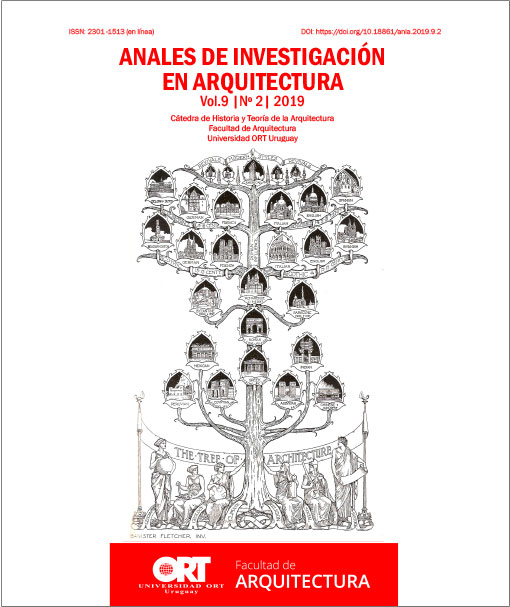Modernity in Mendoza (1890-1930): Cacheuta settlement as mountain testimony
DOI:
https://doi.org/10.18861/ania.2019.9.2.2923Keywords:
Modernity, Cacheuta settlement, infrastructure and architecture, MendozaAbstract
This investigation focuses on the detection of a vacancy of an integral approaching of the cultural goods on the middle section of the Mendoza River, in the central portion of the Argentinian Andes. Nowadays it has been advanced only in a limited look in the study of historical goods that consolidated the territory, which impedes enormously the possibility of reincorporation of such goods as tourist and economic resource for the region.
For the comprehension of the problem it has been proposed an approach to physical space of particular characteristics – sharp slopes, steep morphology of the soil surfaces, stocky vegetation– in a historical time that reveals the transition between the end of 19th century and the beginning of the 20th century, period known as the “modernity”. Starting from the methodology of case study we intended to reveal the coexistence of intentions and investments of public and private management. Particularly, in the area known as “Cacheuta valley”, where some of the effects of this modernity show the introduction of new technologies in productive processes, new ways of social interaction and established the foundations for the permanent historical settlement of this area. The railroad and the road plot constitute the guiding thread that leaded these pioneering interventions.
Downloads
References
ACORDINARO, N. (2009) Desde Luján. Una mirada a los sucesos mendocinos. Mendoza: Municipalidad de Luján de Cuyo
BERMAN, M. (1982) Todo lo sólido se desvanece en el aire: la experiencia de la modernidad. Buenos Aires: Siglo XXI
DÍAZ ARAUJO, E. (2003) Los Fader, empresarios del infortunio, en: Revista de la Junta de Estudios Históricos de Mendoza, 2º Época, Nº 6, T1 (365-392)
GÓMEZ DÍAZ FRANZÓN, A. (2011) Arquitectura del veraneo y su época en Sanlúcar de Barrameda (Cádiz) 1900-1950. Sanlúcar de Barrameda: A.S.E.H.A.
GUTIÉRREZ VIÑUALES, R. (1998) Fernando Fader: obra y pensamiento de un pintor argentino. CEDODAL, Disponible en http://www.ugr.es/~rgutierr/PDF2/LIB%20002.pdf
INCHAUSPE, O. Y MARZO, M. (1967) Geografía de Mendoza. Tomo 1 y 2. Buenos Aires: Ed. Spadoni SA.
LACOSTE, P. (2013) El ferrocarril Trasandino y el desarrollo de los Andes centrales argentino-chilenos (1872-2013) Santiago: Ed. IDEA
LACOSTE, P. (2004). El Ferrocarril Trasandino y la invención de la montaña como espacio social. Entrepasados, 24 (177-198).
LACOSTE, P. (1998). Grandes obras de Mendoza. Aportes para el estudio de la historia del turismo y la Ingeniería. Mendoza: Diario UNO.
LACOSTE, P. y otros (comp.) (2004) Mendoza a través de su historia Mendoza: Caviar Blue
LARRINAGA RODRÍGUEZ, C. (2007). El turismo y la ciudad de San Sebastián en la edad contemporánea. Un análisis en el largo plazo. Il turismo e la cittá tra XVIII e XIX secolo. Italia e Spagna a confronto (108-126).
LARRINAGA RODRÍGUEZ, C. (2005). A Century of turismo in Northern Spain, 1815-1914. Histories of Tourism, Chanel View Press (88-103).
PASTORIZA, E. (2008). El turismo social en la Argentina durante el primer peronismo. Mar del Plata, la conquista de las vacaciones y los nuevos rituales obreros, 1943-1955., en Nuevo Mundo Mundos Nuevos, Debates [En línea], Puesto en línea el 16 junio 2008. URL: http://nuevomundo.revues.org/36472. Consultado el 11 setiembre 2012.
PONTE, J. (1999) La fragilidad de la memoria. Representaciones, prensa y poder de una ciudad latinoamericana en tiempos del modernismo. Mendoza, 1885-1910. Mendoza: Ediciones Fundación CRICYT
SAUTU, R. y otros (2005) Manual de metodología. CLACSO, colección Campus Virtual, Buenos Aires.
SOBRINO SIMAL, J. (2015). Los paisajes históricos de la producción en Cuba, en Esempi di Architettura, Conservación de centros históricos en Cuba. Vol 1. 32 (225-246)
TEDESCHI, E. (1972) Teoría de la Arquitectura. (3a. ed.) Buenos Aires: Ediciones Nueva Visión.
WAISMAN, M. (1972). La estructura histórica del entorno. Buenos Aires: Ediciones Nueva Visión SAIC.
WAISMAN, M. (1993). El interior de la Historia. Historiografía Arquitectónica para uso de Latinoamericanos. Bogotá: ESCALA.
Downloads
Published
How to Cite
Issue
Section
License
The journal and its contents are licensed under the Creative Commons - Attribution 4.0 International License (CC BY 4.0). It is possible to copy, communicate and publicly distribute its content as long as the individual authors and the name of this publication are cited, as well as the publishing institution (Universidad ORT Uruguay).


